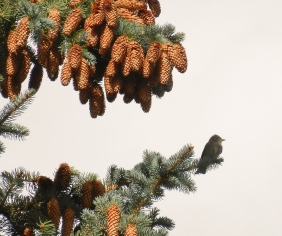 I’ve been waiting and hoping to encounter a new species to blog about, but I didn’t have much luck in November. December wasn’t starting out too well, either, with terrible winds and no snow making it difficult to spend much time outdoors. In an attempt to follow the winter, I took a short trip out to Jackson in the western part of the state and saw my first ever trumpeter swans, Cygnus buccinator.
I’ve been waiting and hoping to encounter a new species to blog about, but I didn’t have much luck in November. December wasn’t starting out too well, either, with terrible winds and no snow making it difficult to spend much time outdoors. In an attempt to follow the winter, I took a short trip out to Jackson in the western part of the state and saw my first ever trumpeter swans, Cygnus buccinator.
E.B. White’s Trumpet of the Swan was one of my favorite books as a kid, but I had never managed to spot one of these guys in the wild. While watching them yesterday, I didn’t hear any extensive trumpeting (and no one seemed to be playing any extra musical instruments), but they did humor me with few cute honks. I thought these birds were endangered, but apparently, their numbers are doing much better, and they are a fairly common sight along Flat Creek at Jackson’s National Elk Refuge just outside of the town.
 The trumpeter swan is the largest swan in the world, and these big white beauties were quite impressive. A handful of these large birds were floating in the icy water alongside dozens of mallards. They were feeding, in cute duck style, with their bottoms straight up in the air. Their pretty white heads and necks were a little stained from dabbling, or as whatbird.com says, “from contact with ferrous minerals in wetland soils.”
The trumpeter swan is the largest swan in the world, and these big white beauties were quite impressive. A handful of these large birds were floating in the icy water alongside dozens of mallards. They were feeding, in cute duck style, with their bottoms straight up in the air. Their pretty white heads and necks were a little stained from dabbling, or as whatbird.com says, “from contact with ferrous minerals in wetland soils.”
Thanks, Jackson Hole, for giving me at least one more new blog post for 2012, not to mention the chance for a little skiing and snowshoeing!























